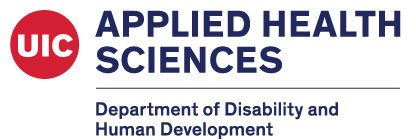by Bridget Fitzgerald, LEND Family Advocate
Image description: Declan, a white teen with brown hair and his mom, Bridget Fitzgerald, a white middle-aged woman with long hair. They are both smiling and wearing “AAC Rocks” t-shirts.
AAC is an acronym for Augmentative and Alternative Communication, the name for the communication tools that individuals who cannot rely on speech or “mouth words” use. For families like mine, AAC has been life-changing. My 14-year-old son, Declan, is a non-speaking autistic teen who uses an AAC device to communicate.
Communication is a Basic Human Right
Communication is a basic human right. For non-speakers, AAC is not a luxury but a necessary tool to communicate. Whenever the topic of AAC comes up, I share my family’s journey and highlight the importance of respecting the voices of non-speakers—whether they have formal communication tools or not.
Presume Competence
There are no prerequisites for AAC. None. We must presume competence that everyone can learn and that everyone has a voice. My child did not take to PECs (picture exchange cards) since they were highly procedural and he was not able to openly express himself. If he was on a trial for school or insurance in which PECs were a precursor and he had to “graduate to an electronic device,” he would have failed miserably and never gained access to communication.
Communication Over Compliance
One of the biggest mistakes I see medical, therapeutic, and educational professionals make is focusing on compliance or behavior management before ensuring a non-speaking child has access to communication and is regulated. For Declan, AAC didn’t just provide words—it gave him control over his own expression. When a non-speaking child can communicate, many of the so-called “behavioral” issues begin to fade because the frustration of being misunderstood starts to dissolve.
Declan’s Journey with AAC
Declan’s life changed the moment he was introduced to his AAC device (a dedicated iPad with the TouchChat app). Although it took nearly two years for him to fully embrace its use, his demeanor improved immediately. Even before he could navigate the device to the proper icons or type out sentences, he knew that his school team and his family were rooting for him. He knew that we presumed his competence. He knew that we believed in his potential to communicate, and that belief made all the difference.
Tone and Engagement Matter for All Non-Speakers
Non-speakers understand far more than most people think. This is true for non-speakers with and without intellectual or developmental disabilities (IDD). Even if a non-speaking person cannot respond using words or formal communication tools, they can understand tone, intent, and body language.
For example, I recently took Declan to a new doctor. While the doctor was somewhat cold toward me, he warmly greeted Declan, using a friendly tone. This was a big improvement over past experiences, where Declan was sometimes ignored altogether. The respect the doctor showed toward Declan set the tone for a more positive visit, even if his communication with me was subpar.
Spellers Need Your Patience
Not all non-speakers use electronic devices. Some use spelling boards or letterboards to communicate, and while the process can be slow, the results are pivotal. I’ve witnessed how spelling opens doors for non-speakers to express complex thoughts, emotions, and ideas that were previously locked inside.
When interacting with a speller, it’s crucial to be patient, allow time, and recognize that the communication process may look different, but it’s no less valid. Clear, direct communication, paired with a supportive and calm environment, gives non-speakers the space to express themselves fully.
For Non-Speakers Without Formal Communication Tools
Before Declan could use his AAC device, he communicated with us in countless ways—through gestures, facial expressions, sounds, and behaviors. As parents, we often interpret these signals and serve as “translators.” But it’s important for professionals to engage directly with non-speakers as well. Speak to the non-speaker, not just about them. Even if they can’t verbally respond, or they appear to not be paying attention, they are processing and understanding more than you might realize.
I’m Not My Child’s Voice
Unlike other parents of non-speakers, I will never say that I am my child’s voice. I’m his advocate, his champion, and his mom but I am not him. I work hard for him to have his own voice and he works even harder.
AAC is not easy yet it is entirely worth it. It requires tons of patience, dedication, and respect from everyone involved. Every person deserves a voice and the opportunity to be heard. Declan, like so many other non-speaking individuals, has a lot to say. And when we provide the tools, support, and respect, we open the door for these critical voices to be heard.
Resources for Communicating with Non-Speakers
Communication First, the only nonprofit dedicated to protecting and advancing the civil rights of the more than 5 million people in the United States who cannot rely on speech alone to be heard and understood.
https://communicationfirst.org
ISAAC, International Society for AAC
https://isaac-online.org/english/home/
I-ASC, International Association for Spelling as Communication
https://i-asc.org
AAC Awareness Month is celebrated every October.








